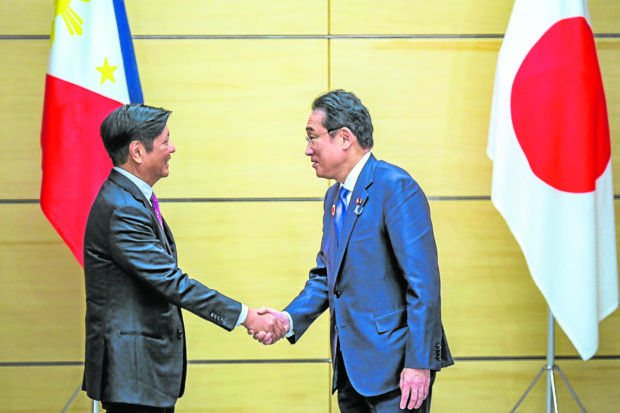
FRUITS OF DIPLOMACY President Marcos greets Japanese Prime Minister Fumio Kishida during a visit to Tokyo last year.—PPA POOL
MANILA, Philippines — President Ferdinand Marcos Jr.’s foreign trips over the past 16 months since he assumed office have begun to bear fruit, with about $14 billion (P782.5 billion) worth of investments starting to take shape, the Department of Trade and Industry (DTI) said on Sunday.
In a statement, the DTI said that as of December 2023, it has recorded some $ 72.2 billion (P4 trillion) worth of foreign investments at various stages, comprising 148 projects, of which 46 projects worth $14.2 billion (P793.7 billion) have already been “actualized.”
READ: Lifting restrictions on foreign investments ‘good for economy’
The department added of the initiated projects, those in the manufacturing sector comprise the largest share with 16 projects (35 percent), followed by the information technology and business process management (IT-BPM) with 10 projects (22 percent); and renewable energy with nine projects (20 percent).
The investments are spread across various sectors, including infrastructure, agriculture, retail, transport, and logistics.
No details yet
The DTI, however, did not cite specific examples of the actualized projects and did not provide details on where these are to be set up.
The Presidential Communications Office also did not respond to a request for data on how much the President has spent on his 20 foreign trips since July 2022.
According to the DTI, a total of 21 projects that are considered “actualized” are from Japan-based companies while 13 projects are from US-based firms. A project is deemed “actualized” once it is already operating, has completed its registration process with the DTI’s Investment Promotion Agencies, or has commenced implementation, the agency said.
The DTI also looks at whether a project has already “spent financial and staff resources to undertake specific, tangible steps for implementing the project” for it to be counted as actualized.
Project planning
The department added for the rest of the 102 projects amounting to $58 billion (P3.2 trillion) in investment pledges that foreign investors are still supposedly conducting “pre-implementation and planning activities” in their respective countries.
“While certain investment projects seamlessly progress from commitment to operation, others require a more extended implementation period of up to seven years in the case of offshore wind and major physical infrastructure projects,” the DTI said.
“The investment flows into the country in phases over the implementation period, during which the project transitions into operational status and begins generating revenues,” it added.
The DTI explained that investment pledges in the IT-BPM sector and light manufacturing have mostly become operational because of their “relatively shorter implementation periods.”
While the FDI (foreign direct investment) values are modest, the early actualization of investment commitments in these sectors contributes to the decrease in the unemployment rate in the Philippines, given that IT-BPM and manufacturing are significant generators of direct employment.
The DTI also did not provide data on how many jobs the supposed actualized projects will generate.
Trade Secretary Alfredo Pascual said that while the president’s foreign visits were “effective” platforms for generating investment pledges, they also required “relentless follow-through and strategic collaboration” to realize them.
“Our dedication to turning investment pledges into reality is unwavering. We also leverage each presidential visit as a springboard for building up a pipeline of investment opportunities and making the Philippines an investment destination of choice,” Pascual added.